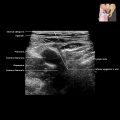KEY FACTS
Terminology
- •
Exencephaly is early manifestation of anencephaly before neural tissue has worn away
Imaging
- •
No calvarium with absence of neural tissue above orbits
- ○
Neural tissue wears away during gestation until no organized neural tissue remains
- ○
Cranial defect covered by angiomatous stroma, which gives “lumpy” configuration in 2nd trimester
- ○
Often contiguous with cervical spine defect
- ○
- •
Should be able to diagnose routinely at 10-14 weeks
- ○
Neural tissue often still present (exencephaly)
- ○
Head has irregular, flattened, splayed appearance
- ○
- •
Proptotic eyes (described as frog-like appearance)
- •
Amniotic fluid often echogenic secondary to dissolved neural tissue
- ○
Polyhydramnios common later in pregnancy
- ○
Top Differential Diagnoses
- •
Amniotic band syndrome
- ○
Calvarium may be absent, but large amount of intact brain often remains
- ○
Look for other defects and presence of fine linear bands
- ○
Important distinction for counseling, as bands are sporadic and have no increased recurrence risk
- –
Exencephaly, anencephaly has 2-5% recurrence risk, and preconceptual folic acid treatment needed for next pregnancy
- –
- ○
Scanning Tips
- •
CRL < expected is not always due to incorrect dates
- •
Endovaginal scanning in 1st trimester for earlier diagnosis
- ○
May still be difficult diagnosis to make before 10 weeks
- ○
Visible tissue of exencephaly may be mistaken for normal brain, so examine cranial contour carefully
- ○
- •
Short-term follow-up for any case when head looks asymmetric or irregular
 . As brain tissue erodes, the appearance changes from exencephaly to anencephaly. Note the increased echogenicity of the amniotic fluid
. As brain tissue erodes, the appearance changes from exencephaly to anencephaly. Note the increased echogenicity of the amniotic fluid  from dissolving neural tissue.
from dissolving neural tissue.
 . This is a lethal malformation, which should be recognized in the 1st trimester.
. This is a lethal malformation, which should be recognized in the 1st trimester.
 , and there is near-complete absence of neural tissue
, and there is near-complete absence of neural tissue  above the orbits.
above the orbits.
Stay updated, free articles. Join our Telegram channel

Full access? Get Clinical Tree








